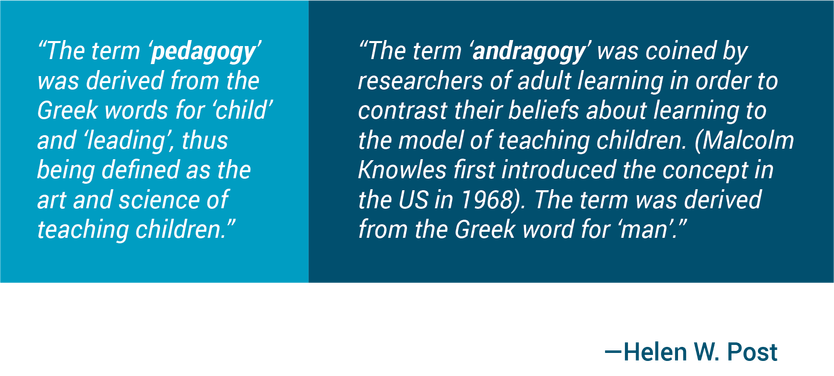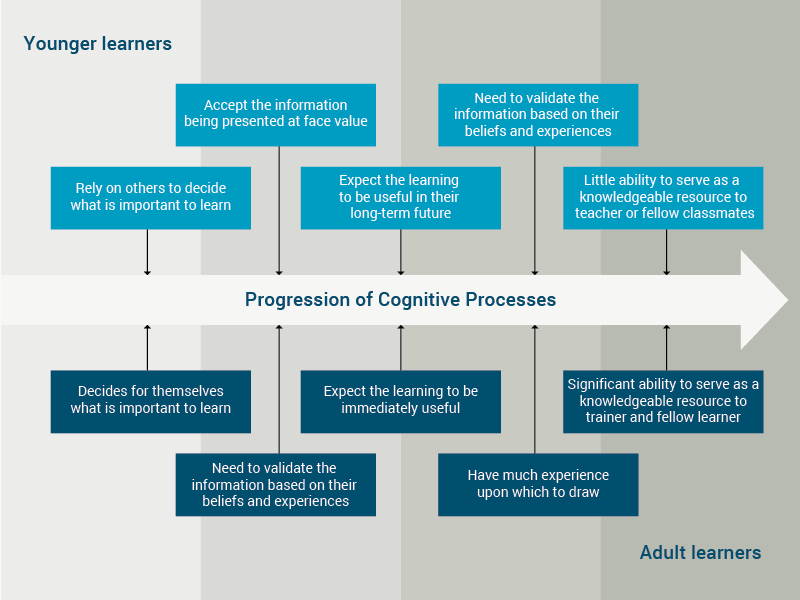
Learning and Instructional Design Strategies for Adult Learners
“Education in the light of present-day knowledge and need calls for some spirited and creative innovations both in the substance and the purpose of current pedagogy.”, said Anne Sullivan, teacher and lifelong companion of Helen Keller. Pedagogy and Andragogy: are they different sides of the same coin, or are they different coins altogether? Let’s look at some industry-accepted definitions:

As indicated above, pedagogy and andragogy focus on different, but not opposing, learning models. Strategies used to design learning for a younger audience cannot be the same as those used for older students because learning needs and goals vary progressively throughout life. The creation and implementation of strategies and best practices related to learning and instructional design strategies are essential. The first step is to examine some primary differences between young learners adult learners. Note: “Adult learners” refers to graduate, continuing education and professional development students.

Let’s translate these characteristics into the following best practices we deploy in learning design for upper-level college students and adult learners:
- Learning objectives must be clear and specific. This enables learners to find data that will lead to achieving learning goals.
- The content architecture gives opportunities for learners to apply their experience in relevant settings. It also provides a chance to share, discuss, and work in collaboration with fellow learners. Group training creates a supportive, responsive environment.
- Content design must not be solely exam-oriented; instead, it should focus on enhancing skills and knowledge. It should help learners acquire practical and applicable skills and competencies rather than end-of-learning assessment skills. Experimental learning and problem-centered strategies play a vital role in this approach.
- Learners should be able to immediately identify the relevance as it applies to the course of study and, in a professional setting, should be able to apply the information they have learned in real-world settings.
- The content itself covers only the ‘need-to-know’ and eliminates the ‘nice-to-know’ information. Sticking to relevant content enhances learner motivation.
Re-envisioning Dated Learning Theories
Learners of today acquire knowledge differently. The digital revolution has moved adult learners out of traditional classrooms and into their homes or dorms, train stations, parks, or coffee shops. Access to digital material on laptops and mobile devices has expanded the range of communication from local classmates to fellow learners and teachers across the world. The digital era has made memorizing data and rote learning less significant than being able to research, locate and analyze it.
It is imperative for instructional designers today to re-evaluate traditional learning theories and design iterations to match the needs of current adult learning requirements. For example, when following Gagne’s Nine Events of Instruction, it is critical to maintain learner attention throughout the learning process rather than simply gaining their attention at the beginning of learning. Instead of spending valuable learning time in memorization and recall, learners should be provided with opportunities to focus on analysis and understanding. It is critical to have the learners evaluate their readiness to learn and adapt the content to what they know when the learning process begins. Changes in approach to learning design, learning architecture and instructional design should be considered when creating a plan – especially when existing courses are being updated.
Immersive scenarios, educational games, personalized learning plans, diagnostic tests, adaptive courseware and virtual reality are emerging as popular trends in adult education as opposed to standard online courses and ILTs that have become archaic in today’s education. Previously, learner involvement meant having to click back/next buttons to see screens of content on the computer; now learner involvement means participation in online discussions, practicing what they learn in a simulated environment, analyzing, defining and creating content, and being involved in the evaluation process. LD and ID strategies today must focus on transporting learners from a passive to a more active environment. Learning theories that facilitate this transformation play a vital role in designing content for adult learners. Some to note include:
- Malcolm Knowles’ Principles
- Keller’s Arcs Model of Motivational Design
- Kirkpatrick’s Levels of Evaluation
- Ruth Clarke’s Principles of Design
While this list is not exhaustive with respect to all appropriate strategies and theories for adult learning, it does attempt to highlight some key considerations. As the cognitive processes and educational settings continue to evolve, instructional strategies that are applicable today may not be applicable tomorrow. However, the implementation of these strategies in today’s learning environment will equip learners with creative, critical, and forward thinking skills and will equip educators as they define strategies appropriate to ever-evolving learning trends.
Conclusion
The adult learners have different needs and goals compared to younger learners, which necessitates a different approach to learning and instructional design. Instructional designers must re-evaluate traditional learning theories and implement new strategies to match the needs of today’s adult learners. Clear and specific learning objectives, content architecture that allows for application and collaboration, practical and applicable content, relevance to real-world settings, and relevant content are essential components of effective instructional design for adult learners. Additionally, the use of immersive scenarios, educational games, personalized learning plans, diagnostic tests, adaptive courseware, and virtual reality are becoming popular trends in adult education. Continual evaluation and adaptation of instructional strategies are essential to equip learners with creative, critical, and forward-thinking skills, and to keep pace with evolving learning trends.
Visit Aptara.com to learn more about instructional design.
Read More:
What are the best Instructional Design Practices?
Design Capabilities for Learning Transformation






No Comments